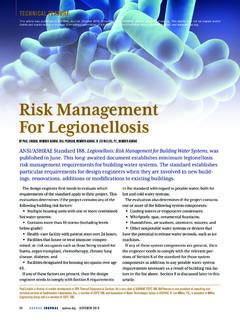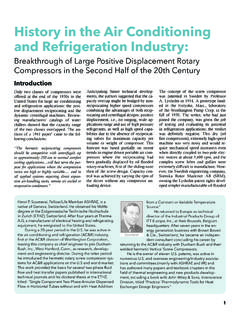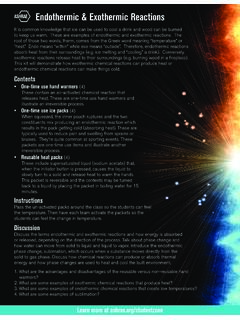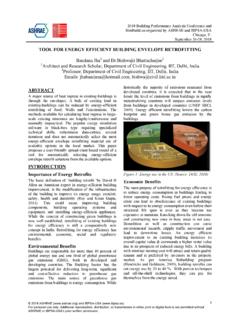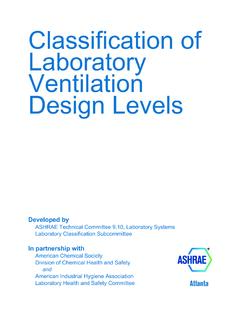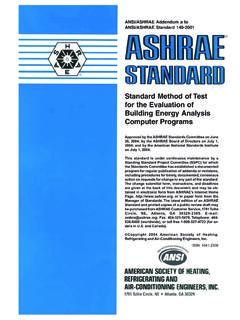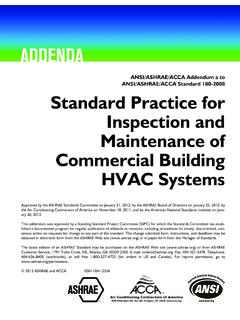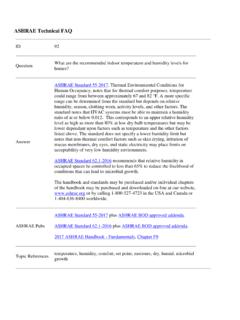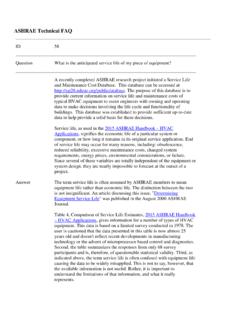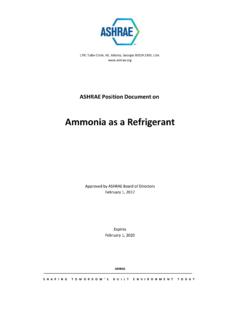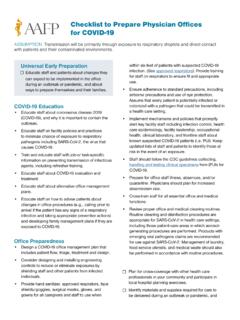Transcription of ASHRAE EPIDEMIC TASK FORCE
1 BACKGROUND/CONTEXT Modes of Transmission ASHRAE Statements on Airborne Transmission and Core Recommendations CDC recommends Airborne Infection isolation rooms for aerosol generating procedures (AGPs) Secondary Infection Susceptibility Committing Airborne Infection isolation rooms for use as inpatient rooms limits future flexibility. Work with clinical staff to establish use requirements. Cohorting Cautions and current methods . See ASHRAE COVID-19 ASHRAE members have provided input onDisaster Planning and Emergency management for Healthcare Facilities. Partner on your local professional engineering partners for input and guidance during this Do No Harm Protect Healthcare Workers, Family, and Visitors Protect Other Patients Empower people to make and carry out the best decision they can. Work as a team weigh competing concerns, define key areas, share the plan. Consider the type of HVAC system, the configuration, clinical needs, facility infrastructure capacity, and limited resources HOW-TO AND UNIQUEAREAS Layered approach for normal and small surge operations Source Control Optionsfor patient beds Operating on COVID-19 positive patient Variable Air Volume Adjustments & Modification to economizer or reduced recirc.
2 Cautions on Recirculating Room Units (Fan coils, induction units, etc.) 2-person patient rooms creating or managing existing Use Operating rooms for inpatient rooms/temp ICU Emergency Department Warning on Older ICU units Transmission through the air in toilet rooms Provide areas for safely doffing PPE, such as shoe cover removal followed by tacky matts for personnel exiting an area. Gastrointestinal EndoscopyFACILITIES/MAINTENANCE PPE basics Filter changing Room turnover Verify performance of critical HVAC systems airborne infection isolation rooms, Emergency Departments, etc. Disinfection: Normal, UV, VHP, Hypochlorous Acid See ASHRAE COVID-19 Filtration and Disinfection section for greater detail. Considering the possibility of being short-staffed in the future, run-test and re-fuel emergency generator system. Coordinate any planned rescheduling or postponement of Inspection, Testing, Maintenance (ITM) with local or state AHJ.
3 Submit waivers as required. Check to be sure COVID-19 area AHU return air isn t being used to condition mechanical rooms. Waterborne Pathogen EPIDEMIC TASKFORCEHEALTHCARE| Updated4-18-2021 SUGGESTED APPROACHES Passive isolation Strategically utilize AII Rooms Airflow from Clean to Less Clean Increase Filtration Level if possible Guidance on Recirculation and Increased Outside AirMaintain relative humidity at 40-60%. Evaluate continued operation of recovery wheels Improve/Consider room airflow direction/patterns Utilize portable ante rooms/vestibules with HEPA filtration Utilize UV light (see Facilities/Maintenance Disinfection) Areas for non-COVID patients should still be treated with care because someone could be unknowingly GAS/VACUUM SYSTEMS Demand for gasses in ICU rooms Demand for gasses in med-surg rooms and OR s Accommodating increased demand (flow) in fixed piping systems Impact of demand/consumption on existing gas systems Consider providing supplementary gas sourcesLIFESAFETY Confirm that power-consuming equipment is connected to the appropriate branch of the essential power system.
4 Maintain Egress Consider defend-in-place plans and smoke compartments Increased facility oxygen use elevates risk of a fire spreading more rapidly First responder protection. Develop Interim Life Safety Measures as applicableSURGE AREAS Initial Considerations Alternate Care Site Design Concepts Single patient room considerations vs. 2-patient rooms General Parameters for ACH, Temp, Filtration, and RHOTHER Reduce # of rooms utilized off a single HVAC system to free up AHU capacity to achieve performance goals. 25 beds with desired airflow/temps better than 30 beds with airflow/temp deficiencies. Document the Action Plan and Alternations in PlaceObtain AHJ approval for long-term alternations. Healthcare Team Members Acknowledgements & DisclaimerModes of Transmission SARS-CoV-2, the virus that causes COVID-19, is transmitted by various pathways. One such pathway is person-to-person transmission through the inhalation of respiratory droplets when someone with COVID-19 coughs, sneezes, or talks.
5 It has also been recognized that SARS-CoV-2 is transmitted through inhalation of smaller virus-containing aerosols over distances exceeding 12 feet in special settings. Current data do not support long range aerosol transmission as a primary transmission pathway, such as seen with measles or tuberculosis. To date, no data has documented the transmission of SARS-CoV-2 through HVAC systems and subsequently causing a COVID-19 infection, but that potential continues to be researched. See ASHRAE Statements on Airborne Transmissionand the Environmental Health Emerging Issue Brief, Pandemic COVID-19 and Airborne Transmission . Recognize That Virus May Be Aerosolized During Toilet Flushing, even in subsequent flushes following initial use by an infectious person. Keepingplumbing traps full of water or mineral oil to avoid transmission of sewer aerosols through dry traps. SARS-CoV-1 and SARS-CoV-2 have both been shown to be transmitted this way, and two SARS-CoV-2published studies posited Transmission Statement & Core Recommendations*NEW* ASHRAE Statement on airborne transmission of SARS-CoV-2 Airborne transmission of SARS-CoV-2 is significant and should be controlled.
6 Changes to building operations, including the operation of HVAC systems can reduce airborne Statement on operation of heating, ventilating, and air-conditioning systems to reduce SARS-CoV-2 transmission Ventilation and filtration provided by heating, ventilating, and air-conditioning systems can reduce the airborne concentration of SARS-CoV-2 and thus the risk of transmission through the air. Unconditioned spaces can cause thermal stress to people that may be directly life threatening and that may also lower resistance to infection. In general, disabling of heating, ventilating, and air-conditioning systems is not a recommended measure to reduce the transmission of the virus.*NEW* ASHRAE Core Recommendations for Reducing Airborne Infectious Aerosol Exposure are available HERE. Aerosol Generating ProceduresIt is possible that the virus is spread through aerosol, so minimize aerosol generating procedures. positive pressure ventilation (BiPAP and CPAP) endotracheal intubation airway suction high frequency oscillatory ventilation tracheostomy chest physiotherapy nebulizer treatment sputum induction BronchoscopySecondary Infection SusceptibilitySecondary infections are a significant complicating factor for patients with are studies that show a significant portion of patients with COVID-19 also acquire another infectious disease.
7 Clinical course and risk factors for mortality of adult inpatients with COVID-19 in Wuhan, China: a retrospective cohort study:This study showed how developing a co-infection (secondary infection) from a hospital when a patient is dealing with COVID-19 increases the likelihoodof death by 27 times. Precautions are Needed for COVID-19 Patients with Coinfection of Common Respiratory Pathogens: Among COVID-19 patients in Qingdao, of them had IgM antibodies against at least one respiratory pathogen, whereas only of the patients in Wuhan had positive results for serum IgM antibody detection. The most common respiratory pathogens detected in Qingdao COVID-19 patients were influenza virus A ( ) and influenza virus B ( ), followed by mycoplasma pneumoniae ( ) and legionella pneumophila ( ).Legionella Pneumophila is a waterborne pathogen from the plumbing system and needs to still be addressed. Co-infection with SARS-CoV-2 and Influenza A Virus in Patient with Pneumonia, China -We report co-infection with severe acute respiratory syndrome coronavirus 2 (SARS-CoV-2) and influenza A virus in a patient with pneumonia in China:The case highlights possible co-detection of known respiratory viruses.
8 Low sensitivity of upper respiratory specimens for SARS-CoV-2 could further complicate recognition of the full extent of :Cautions and Current methods Clinicians have advocated against cohorting suspected and confirmed patients to avoid the potential for conversion. Coordinate with your clinical staff in this manner. Do designate specific area outside or in ED for respiratory cases In order to manage patient influx, congestion, and to control the risk of exposure to healthcare workers, consider designating a specific area in the ED for respiratory cases. Do triage Persons Under Investigation (PUI) capable of self-care outside the ED, either through drive-through or walk-up screening stations set up in tents or temporary spaces, andadvise continuing home care until results are available. Do consider designating entire units to care for COVID patients. Conserves PPE Improves containmentAlternate Care SitesClinical Goals Will Dictate Infrastructure Needed Determine if space is for COVID-19 Confirmed, suspected, or non-COVID-19 Patients and at what acuity level.
9 Do not cohort suspected & confirmed patients. Consider locations for staff respite areas. Consider Liability Issues If Diverging From FGI/State Guidelines ASHE Note:During emergencies, it is important that activities be coordinated through the organization s incident command system. Activities outside of an organization s command structure should be coordinated with the local, county and state incident command systems. This enables effective and efficient incident management within common organizational Info on Expedient Patient isolation Rooms ASHRAE and the US Army Corps of Engineers partnered to produce the Alternate Care Site HVAC Guidebook, available for free download HERE. Suggested locations to consider for COVID-19 surge space are listed below. These areas should be considered in relation to the current state of an EPIDEMIC . Some areas may not be available for use as facilities reestablish elective services.
10 Ambulatory Surgery Centers Operating Rooms Administration areas that used to be patient space Consider areas served by the same AHU, on the same floor, within a single suite , or within the same smoke zone. Links to Images/Concepts for surge spaceConcepts for sites, including schools, parking garages, hotels, etc. can be found through this ASHE website: Converting alternate care sites to patient space optionsAlternate Care SitesIssues to Plan for and Address: Staffing -Adequate Skilled Care Providers and Support Staff Supplies -PPE, Beds, Equipment, Infrastructure including HVAC, Power, Internet Access, and Medical Gas. Space -Site Evaluations and Proximity to Hospital and Areas of Demand Do Not Ignore Access to Toilets and Hand Washing (Challenge at Large Volume Spaces Like Convention Centers). Common toilet areas could contribute to transmission and viral load. Changes in climate over time that may stress system capacity.
